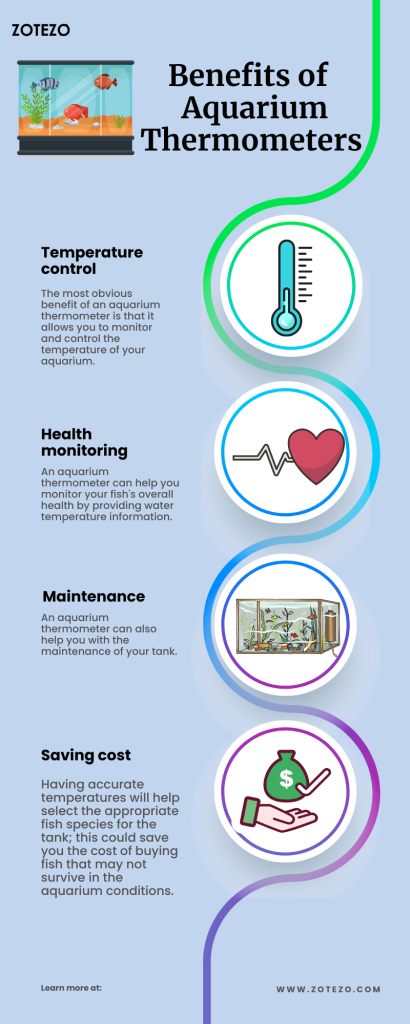Introduction
An accurate temperature reading is one of the essential components of maintaining a successful aquarium. Without it, fish and other aquatic species don’t thrive and can even become sick or die. Fortunately, several excellent thermometers on the market allow hobbyists to keep tabs on their tank’s temperature easily; these devices ensure their tanks stay healthy and everyone inside remains happy.
But, with so many options flooding the market, it can take time to choose the best one that fulfills your ideal requirements. You may be in confusion wondering about below questions:
1. Which aquarium thermometer is good?
2. What are its benefits or disadvantages?
3. What to look for while buying an aquarium thermometer?
That’s why we’re here to help. We will review some of the top aquarium thermometers available in order to help make your search easy so you know which one is right for you! Please keep reading to learn more about our top picks.
Discover more than just aquarium thermometers; we’ve got an array of Best ferret cages and Best guinea pig cages for your cherished pets. Whether your furry friend is a playful ferret or a cuddly guinea pig, we have spacious and cozy options to suit their needs. Treat them to a comfortable and nurturing environment with our carefully crafted cages, ensuring they live their best lives with you.

Our pick of the 6 best Thermometers for Aquarium of 2024 in Sweden
Zotezo Score | Best Aquarium Thermometers | Lowest Price |
|---|---|---|
|
B+ |
||
|
B |
||
|
B |
||
|
B |
||
|
C+ |
||
|
C+ |
Let's take a deep dive into these 6 best Aquarium Thermometers in Sweden
Best Overall Aquarium Thermometers in Sweden
Hygger
B+
Zotezo review
The Hygger submersible digital aquarium heater offers adjustable temperature control, an LED temperature display, and wide compatibility with various tank sizes. However, it has limited temperature control options and may not fit all tank sizes. Overall, it is a versatile and convenient option for maintaining optimal water temperature in aquariums.
Product details
Benefits of Hygger Submersible Aquarium Heater
Drawbacks
B
Zotezo review
The YOUTHINK Aquarium Thermometer with LCD Digital Display is a reliable and versatile thermometer suitable for reptile incubators, aquariums, brooders, and greenhouses. It features a clear and easy-to-read display and a secure suction cup attachment, although it may have limited compatibility with certain types of aquariums and may require occasional recalibration.
Product details
Benefits of YOUTHINK LCD Digital Aquarium Th...
Weaknesses
United Kingdom
B
Zotezo review
The Marina Aquarium Floating Glass Thermometer provides accurate temperature measurement and features an easy-to-read display, making it convenient for monitoring water temperature. However, some users have reported that the thermometer is fragile and has a limited temperature range.
Product details
Benefits of Marina Floating Glass Thermometer
Disadvantages
WINGONEER
B
Zotezo review
The WINGONEER Digital Thermometer is a reliable and convenient temperature monitor with accurate readings, an easy-to-read LCD display, and an external probe for versatile usage. However, it has limited compatibility and color options.
Benefits of WINGONEER Digital Thermometer &#...
Negatives
C+
Zotezo review
The Fish Tank Thermometer with Suction Cup is a reliable and user-friendly thermometer that accurately measures the temperature of aquarium water. Its easy installation and versatile design make it a convenient choice for both indoor and outdoor use. However, some users have reported issues with the fragility of the suction cup and the thermometer’s limited temperature range.
Product details
Benefits of Aquarium Thermometer with Suctio...
Cons
C+
Zotezo review
The Digital Swimming Pool Thermometer Floating is a versatile and reliable tool for accurately measuring water temperature in various settings such as pools, bathrooms, aquariums, and sinks. While it offers accurate and consistent readings, it has a limited temperature range and does not come with batteries.
Product details
Benefits of PLUT Digital Floating Pool Therm...
Drawbacks
Tips for choosing the right Thermometers for Aquarium for you
When choosing an aquarium thermometer, there are a few key factors to consider:
Accuracy
The most important thing to look for in an aquarium thermometer is accuracy. Make sure the thermometer you choose has been calibrated and can give you a precise reading.
Type of thermometer
There are several aquarium thermometers, including stick-on thermometers, floating thermometers, and digital thermometers. Each type has its pros and cons, so choosing one that is right for your needs is essential.
Ease of use
Make sure the thermometer is easy to read and understand. Some thermometers may be challenging to read in low light conditions, so choose one that is easy to see.
Durability
Aquariums can be challenging environments for any equipment, so choose a thermometer that is built to last. A durable thermometer made from high-quality materials will ensure that it can stand up to the demands of an aquarium.
Size
Make sure to choose a thermometer that is the right size for your tank and only takes up a little space. A too-large thermometer can be obtrusive and take up space that could be used for other equipment.
Waterproof
It is best to choose a waterproof thermometer to prevent accidents; thus, it is more durable.
It’s always good to read the customer review on the product page before making a purchase.
It’s worth noting that you should always have two thermometers in case one malfunctions, as temperature monitoring is crucial to the health of your aquarium inhabitants.
Products listed here are carefully reviewed and tested by our expert authors and reviewers. If you buy through links on this page, we may earn a small commission. Here’s our editorial process.
How we reviewed these products
Advantages of using Thermometers for Aquarium
Aquarium thermometers have several benefits that help keep your fish healthy and your aquarium running smoothly:
Temperature control
The most obvious benefit of an aquarium thermometer is that it allows you to monitor and control the temperature of your aquarium. Fish and other aquatic organisms have specific temperature requirements, and an aquarium thermometer can help you ensure that the water in your tank is within the acceptable range for your particular species.
Health monitoring
An aquarium thermometer can help you monitor your fish’s overall health by providing water temperature information. Sudden temperature changes can signify a problem, such as a malfunctioning heater or a dirty filter.
Maintenance
An aquarium thermometer can also help you with the maintenance of your tank. By monitoring the temperature of your tank, you can ensure that your equipment, such as your heater and filter, is working correctly and make any necessary adjustments.
Saving cost
Having accurate temperatures will help select the appropriate fish species for the tank; this could save you the cost of buying fish that may not survive in the aquarium conditions.
Breeding
Many species of fish require specific temperature ranges for breeding and incubation. An aquarium thermometer can help you ensure that the water in your tank is at the proper temperature for breeding and incubation.
Safety
With an aquarium thermometer, you can ensure that the water temperature is safe for the fish and other aquatic life in the tank. When water temperatures are too high or too low, it can cause stress to fish and other marine organisms, leading to disease and even death.
Using an aquarium thermometer, you can ensure that the conditions in your aquarium are optimal for the health and well-being of your fish and other aquatic organisms.
Disadvantages of Aquarium Thermometers
While aquarium thermometers are generally considered to be a beneficial tool for maintaining a healthy aquarium, there are a few potential disadvantages to consider:
Accuracy
Some aquarium thermometers may not be as accurate as others, so it’s essential to choose a thermometer that is known for its accuracy and has been calibrated.
Battery
Some types of thermometers, like digital thermometers, may require batteries, and changing them can be a hassle.
Cost
Some aquarium thermometers can be expensive, especially digital ones with advanced features.
Placement
Depending on the type of thermometer, it may be placed in a specific location in the tank, making it hard to see or read.
Breakable
Some thermometers, like floating glass, could be breakable if handled roughly.
Limited measurement range
Some thermometers can only measure temperature over a limited range, so if you need to measure a wide range of temperatures, you may need to purchase a thermometer with a broader scope.
Calibration
Some thermometer types may require regular calibration to ensure the accuracy of the measurement, which could be inconvenient.
Overall, aquarium thermometers are a valuable tool for maintaining a healthy aquarium, and the disadvantages mentioned above should encourage you to get one. Still, it’s essential to be aware of them and choose one that best suits your needs and budget.
How to Use an Aquarium Thermometer
Using an aquarium thermometer is relatively straightforward, but it can vary depending on your type of thermometer. Here are the general steps for using an aquarium thermometer:
Place the thermometer in the aquarium
Depending on the type of thermometer you have, you may need to stick it to the side of the tank, float it in the water, or submerge it in the water.
Allow the thermometer to stabilize
After placing the thermometer in the aquarium, allow it to stabilize for a few minutes to give an accurate reading.
Read the temperature
Once the thermometer has stabilized, you can read the temperature. The temperature should be displayed on the screen if you have a digital thermometer. For other types of thermometers, you may need to read the temperature from a dial or a gauge.
Record the temperature
Keep a record of the temperature readings to monitor the temperature over time.
Compare with the ideal range
Compare the thermometer’s temperature reading with the ideal temperature range of the specific fish species you have in your tank.
Adjust temperature if needed
If the temperature is outside the ideal range, adjust the temperature by adjusting the heater, adding/removing ice packs, or using an aquarium chiller if needed.
Repeat measurement
Repeat the measurement at different times of the day to ensure that the temperature is consistent.
Calibrate your thermometer
Calibrate your thermometer at least once a month to ensure the accuracy of the measurement.
It’s essential to monitor the temperature of your aquarium regularly to ensure that the water is at the proper temperature for the species you are keeping, as fluctuation can harm your fish or other aquatic organisms. A thermometer is a must-have equipment for any aquarium, so make sure you have one and use it regularly to keep your tank inhabitants healthy.
Types of Aquarium Thermometers
Several different types of aquarium thermometers are available, each with its own pros and cons. Here are a few of the most common types:
Floating thermometer
These are simple, inexpensive thermometers designed to float on the water’s surface. They typically have a small dial or gauge that displays the temperature. Floating thermometers are easy to use and can be placed anywhere in the tank. However, they can be challenging to read in low light conditions and may not be as accurate as other thermometers.
Stick-on thermometer
These thermometers are designed to stick to the side of the tank and typically have a small dial or gauge that displays the temperature. Stick-on thermometers are easy to install and can be placed conveniently. However, they can be challenging to read in low light conditions and may not be as accurate as other thermometers.
Digital thermometer
This type of thermometer usually comes in two parts, one part is a sensor which is placed inside the water, and the other part, the display unit, is kept outside. They are typically more accurate than different types of thermometers, have a digital display, and come with various features such as min/max temperature, temperature alarm, and temperature trend. However, they are often more expensive than other types of thermometers, and they may require batteries.
Glass thermometer
This thermometer is similar to a floating thermometer but is made of glass. They are very accurate and can be placed in any location in the tank, but they can be fragile and may require regular calibration.
Infrared thermometer
These thermometers measure the temperature from a distance and do not need to come in contact with the water. They are considered very accurate but are usually expensive.
Probe thermometer
This thermometer is a long metal tube with a temperature sensor inserted into the water and gives a digital reading. They are accurate and easy to use, but the probe can obstruct the aquatic organisms and may require a specific location in the tank to insert.
Ultimately, the type of thermometer you choose will depend on your specific needs, budget, and the equipment you already have. It’s always a good idea to read reviews and talk to other aquarium enthusiasts to understand what might work best for you.
Disdvantages of using Aquarium Thermometers
Generally, using an aquarium thermometer poses minimal risk to aquarium inhabitants. However, poorly maintained or inaccurate thermometers can potentially lead to incorrect temperature readings, which may result in temperature fluctuations harmful to sensitive fish or other aquatic life. Regular cleaning and calibration can help mitigate any potential side effects.
Who should use Thermometers for Aquarium
Aquarium thermometers are essential tools for anyone who keeps fish or other aquatic creatures in a tank. Whether you’re a beginner or an experienced hobbyist, monitoring water temperature is crucial for the health and well-being of your aquatic pets. Aquarium thermometers help ensure that the water remains within the optimal temperature range for the specific species you’re keeping, promoting their overall health and minimizing stress.
How to use Aquarium Thermometers
Here’s a step-by-step guide on how to use an aquarium thermometer:
- Select the Right Thermometer: Choose a thermometer suitable for your aquarium type, whether it’s a stick-on thermometer, a floating thermometer, or a digital probe thermometer.
- Placement: Place the thermometer in an easily visible area of the aquarium, ensuring it’s fully submerged in the water but not obstructing the movement of fish or other inhabitants.
- Wait for Stabilization: Allow the thermometer a few minutes to stabilize and accurately reflect the temperature of the water. This is especially important for stick-on thermometers, as they might take a bit longer to adjust.
- Read the Temperature: Check the temperature reading displayed on the thermometer. Different types of thermometers will have different displays; ensure you understand how to read yours accurately.
- Calibrate if Necessary: Some thermometers may need calibration to ensure accuracy. Refer to the manufacturer’s instructions for calibration procedures, if required.
- Monitor Regularly: Make it a habit to check the aquarium temperature regularly, especially if you’re keeping sensitive fish species or during extreme weather conditions when temperature fluctuations are more likely.
- Adjust if Needed: If the temperature is outside the optimal range for your aquarium inhabitants, take appropriate measures to adjust it. This might involve adjusting the heater or cooler settings, depending on the situation.
- Maintain and Clean: Keep the thermometer clean and free of algae or other debris to ensure accurate readings. Regular maintenance will help prolong its lifespan and accuracy.
Understand the who, what & why behind your favourite products
Brand Values | Product Philosophy | Product USPs
Read brand stories, their raison-d'etre, and understand what drives them to caringly create the highest quality products for your well-being.
Brand stories
Frequently asked questions on Thermometers for Aquarium
1. How accurate do aquarium thermometers need to be?
2. How often should I check the temperature of my aquarium?
3. Is it okay for the temperature of my aquarium to fluctuate during the day?
4. How do I calibrate my aquarium thermometer?
5. My thermometer shows a temperature different from my heater; which one should I trust?
6. Can I use a meat thermometer for my aquarium?
7. How long will an aquarium thermometer last?
Expert reviews you can rely upon
Expert Insights | Product Reviews | Connect with Experts
Gain valuable insights and read unbiased product reviews by subject matter Experts on Zotezo, the ultimate trust commerce platform, that empowers millions globally to make informed decisions for their wellbeing.
Expert Advisory
Conclusion
To ensure that your fish are healthy and thrive in their natural habitat, you must maintain the water temperature comfortably. The best way to do this is by investing in an aquarium thermometer. By taking the time to read reviews and compare products, you can find the perfect thermometer for your needs. Once you’ve found the right one, let us know which one you chose!











